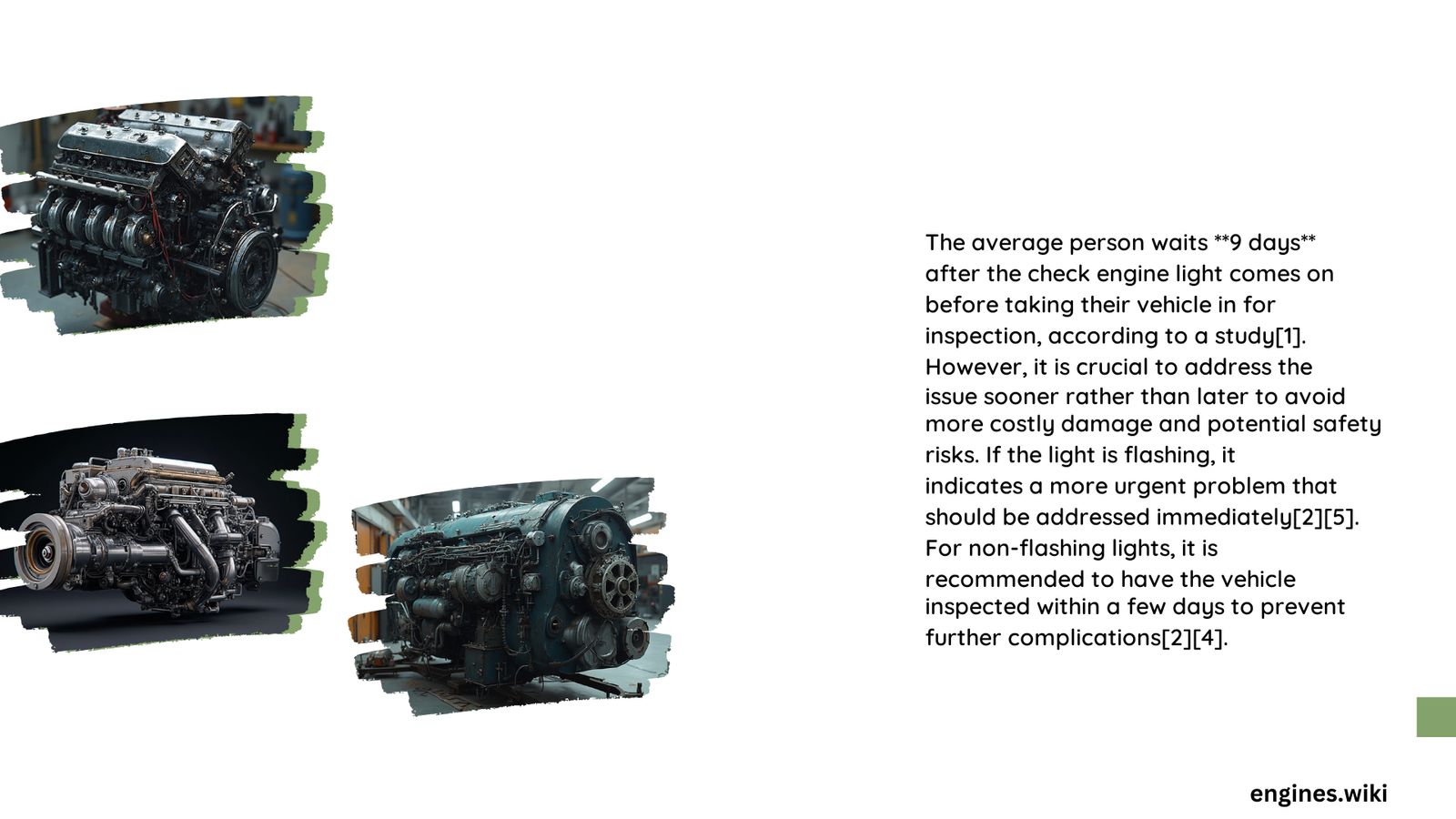The check engine light is a crucial indicator of your vehicle’s health. When it illuminates, it signals potential issues that require attention. The urgency of response depends on whether the light is solid or flashing, with flashing lights indicating more severe problems. This guide explores the recommended timeframes for addressing check engine lights, immediate actions to take, diagnostic steps, and the risks of ignoring this warning signal.
What Is the Recommended Timeframe for Responding to a Check Engine Light?
The urgency of responding to a check engine light varies based on the nature of the issue:
- Solid Light:
- Indicates a less severe problem
- Can often wait a few days to be addressed
-
Should be checked at your earliest convenience to prevent potential escalation
-
Flashing Light:
- Signals a serious problem (e.g., engine misfire)
- Requires immediate attention
- Stop driving as soon as possible and have the vehicle towed to a repair facility
It’s crucial to note that even for solid lights, addressing the issue promptly can prevent more significant problems and costly repairs down the line.
What Immediate Actions Should Be Taken When the Check Engine Light Comes On?

When your check engine light illuminates, take these immediate steps:
- Check the dashboard for additional warning lights or messages
- Inspect the gas cap to ensure it’s securely tightened
- Use an OBD-II scanner to read diagnostic trouble codes (DTCs)
- Consult a professional mechanic if unable to identify the issue
Gas Cap Inspection
A loose gas cap is a common cause of check engine lights. Here’s how to check it:
- Pull over safely
- Turn off the engine
- Locate the gas cap
- Remove and reattach the cap, ensuring it clicks into place
- Drive for a few miles to see if the light turns off
If the light persists after tightening the gas cap, further diagnosis is necessary.
How Long Does It Take to Diagnose Check Engine Light Issues?
The diagnostic timeframe can vary depending on the complexity of the problem:
| Diagnostic Step | Timeframe |
|---|---|
| Initial OBD-II scan | 5-10 minutes |
| Detailed diagnosis | 30 minutes to several hours |
| Multiple drive cycles | 1-3 days |
Some issues may require multiple drive cycles under specific conditions to gather enough data for accurate diagnosis. This process can take up to three consecutive drive cycles under similar conditions.
What Are the Risks of Ignoring a Check Engine Light?
Ignoring a check engine light can lead to several risks:
-
Engine Damage: Especially with flashing lights, ignoring the warning can result in significant engine damage.
-
Increased Emissions: Problems like malfunctioning oxygen sensors or catalytic converters can lead to:
- Higher pollution levels
-
Failed emissions inspections
-
Reduced Fuel Efficiency: Issues such as faulty mass airflow sensors can decrease fuel economy, leading to higher fuel costs over time.
-
Costly Repairs: Addressing problems early can prevent more significant and expensive repairs later.
Potential Cost Comparison
| Issue | Early Repair Cost | Delayed Repair Cost |
|---|---|---|
| Loose gas cap | $0 (DIY fix) | $0-$50 (professional check) |
| Oxygen sensor | $200-$300 | $500-$1000 (if catalytic converter damaged) |
| Catalytic converter | $500-$2000 | $2000-$3500 (if engine damage occurs) |
How Can You Prevent Check Engine Light Issues?
To minimize the occurrence of check engine light problems:
- Follow your vehicle’s recommended maintenance schedule
- Use high-quality fuel and oil
- Address minor issues promptly
- Keep your gas cap tight
- Regularly check fluid levels
- Pay attention to changes in vehicle performance
By following these preventive measures, you can reduce the likelihood of unexpected check engine light activations and maintain your vehicle’s health.
Remember, the check engine light is your vehicle’s way of communicating potential issues. Responding promptly and appropriately can save you time, money, and ensure your safety on the road.
References:
[1] https://lakearborauto.com/check-engine-light-serious-problem/
[2] https://community.cartalk.com/t/how-many-drive-cycles-takes-for-engine-light-to-go-off-after-repair/38128
[3] https://caradvise.com/simple-guide-to-the-check-engine-light/
[4] https://www.kbb.com/car-advice/what-to-do-when-your-check-engine-light-comes-on/
[5] https://www.cars.com/articles/what-does-the-check-engine-light-mean-1420680584968/
